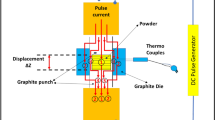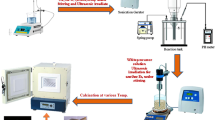Abstract
Hydroxyapatite (HAp) powders were prepared successfully using microwave-assisted co-precipitation method. HAp powder was characterized by X-ray diffraction (XRD), fourier transform infrared spectroscopy (FT-IR) and Raman spectroscopy for structural confirmation of the prepared material. Further, six composites of HAp with SrCO3 and ZrO2 were synthesized to study the morphological and tribological behaviour. Three composites of HAp with three varying 2, 4, 6 wt% of SrCO3 and similarly other three with ZrO2 were prepared using solid-state route method. Scanning electron microscopy (SEM) analysis confirmed that the presence of SrCO3 and ZrO2 among HAp particles helps in grain growth during the sintering processes. The tribological study reveald that the inclusion of SrCO3 and ZrO2 in pure HAp enhanced the resistance to wear and specific wear rate. The average grain size of HAp–ZrO2 was observed more in comparision to the average grain size of the HAp–SrCO3. The values of the specific wear rate and wear of HAp–SrCO3 and HAp–ZrO2 composite ceramics lies in the range from 4.13,239 × 10−5 to 5.44517 × 10−5 mm3/Nm and 4.68693 × 10−5 to 6.10099 × 10−5 mm3/Nm, respectively.











Similar content being viewed by others
References
Hench LL, Wilson J (1984) Surface-active biomaterials. Science 226:630–636
Hench LL, Splinter RJ, Allen WC, Greenlee TK (1971) Bonding mechanisms at the interface of ceramic prosthetic materials. Biomed Mater Res 5:117–141
Roy M, Bandyopadhyay A, Bose S (2011) Induction plasma sprayed Sr and Mg doped nano hydroxyapatite coatings on Ti for bone implant. J Biomed Mater Res 99B:258–265
Santavirta S, Takagi M, Nordsletten L, Anttila A, Lappalainen R, Konttinen YT (1998) Biocompatibility of silicon carbide in colony formation test in vitro A promising new ceramic THR implant coating material Clinical and Exp. Forum 118:89–91
Hench LL, Polak JM, Xynos ID, Buttery LDK (2000) Bioactive materials to control cell cycle. Mater Res Innov 3:313–323
Dorozhkin SV (2010) Calcium orthophosphates as bioceramics: state of the art. J Funct Biomater 1:22–107
Yazdanpanah Z, Bahrololoom ME, Hashemi B (2015) Evaluating morphology and mechanical properties of glass-reinforced natural hydroxyapatite composites. J Mech Behav Biomed Mater 21:36–42
Hench LL (1991) Bioceramics: from concept to clinic. J Am Ceram Soc 74:1487–1510
Mobasherpour I, Heshajin MS, Kazemzadeh A, Zakeri M (2007) Synthesis of nanocrystalline hydroxyapatite by using precipitation method. J Alloys Compd 430:330–333
Regi MV, Colilla M, Gonzalez B (2011) Medical applications of organic-inorganic hybrid materials within the field of silica-based bioceramics. Chem Soc Rev 40:596–607
Yuhta T, Kikuta Y, Mitamura Y, Nakagane K, Murabayashi S, Nishimura I (1994) Direct bone formation on alumina bead composite. J Biomed Mater Res 28:217–224
Zeng S, Cao W, Liu G (1995) Biological evaluation of bioceramic materials-a review. Int Symp Ceram Med 8:461–464
Nathanael AJ, Mangalaraj D, Chen PC, Ponpandian N (2011) Enhanced mechanical strength of hydroxyapatite nanorods reinforced with polyethylene. J Nanopart Res 13:1841–1853
Asgharzadeh H, Shirazi MR Ayatollahi, Naimi-Jamal MR (2015) Influence of hydroxyapatite nano-particles on the mechanical and tribological properties of orthopedic cement-based nano-composites measured by nano-indentation and nano-scratch experiments. J Mater Eng Perform 24:3300
Lahiri D, Singh V, Benaduce AP, Sealb S, Kos Lidia, Agarwal A (2011) Boron nitride nano tube reinforced hydroxyapatite composite: mechanical and tribological performances and in-vitrobiocompatibility to osteoblasts. J Mech Behav Biomed Mater 4:44–56
Ayatollahi MR, Yahya MY, Shirazi HA, Hassan SA (2015) Mechanical and tribological properties of hydroxyapatite nanoparticles extracted from natural bovine and the bone cement developed by nano- sized bovine hydroxyapatite filler. Ceram Int 41:10818–10827
Bodhak S, Nath S, Basu B (2009) Friction and wear properties of novel HDPE-HAp-Al2O3 biocomposites against alumina counterface. J Biomater Appl March 23:407–433
Zhou C, Deng C, Chen X, Zhao X, Chen Y, Fan Y, Zhang X (2015) J Mech Behav Biomed Mater 48: 1–11
André RS, Paris EC, Gurgel MFC, Rosa ILV, Paiva-Santos CO, Li MS, Varela JA, Longo E (2012) Structural evolution of Eu-doped hydroxyapatite nanorods monitored by photoluminescence emission. J Alloys Compd 531:50–54
Menea RU, Mahabole MP, Mohite KC, Khairnar RS (2014) Fe doped hydroxyapatite thick films modified via swift heavy ion irradiation for CO and CO2 gas sensing application. J Alloys Compd 584:487–493
Mishra VK, Bhattacharjee BN, Parkash O, Kumar D, Rai SB (2014) Mg-doped hydroxyapatite nanoplates for biomedical applications: a surfactant assisted microwave synthesis and spectroscopic investigations. J Alloys Compd 614:283–288
Shih WJ, Chen YF, Wang MC, Hon MH (2004) Crystal growth and morphology of the nano- sized hydroxyapatite powders synthesized from CaHPO4·2H2O and CaCO3 by hydrolysis method. J Cryst Growth Des 270:211–218
Fathi MH, Hanifi A (2007) Evaluation and characterization of nanostructure hydroxyapatite powder prepared by simple sol gel method. Mater Lett 16:3978–3983
Yoshimura M, Suda H (1994) Effect of operation conditions on HA synthesized by the hydrothermal method. J Mater Sci 29:51–54
Mishra VK, Srivastava SK, Asthana BP, Kumar D (2012) Structural and spectroscopic studies of hydroxyapatite nanorods formed via microwave-assisted synthesis route. J Am Ceram Soc 95:2709–2715
Mishra VK, Rai SB, Asthana BP, Parkash O, Kumar D (2014) Effect of annealing on nanoparticles of hydroxyapatite synthesized via microwave irradiation: structural and spectroscopic studies. Ceram Int 40:11319–11328
Liu J, Li K, Wang H, Zhu M, Xu H (2005) Self-assembly of hydroxyapatite nanostructures by microwave irradiation. Nanotechnology 16:82–87
Qian WY, Sun DM, Zhu RR, Du XL, Liu H, Wang SL (2012) pH-sensitive strontium carbonate nanoparticles as new anticancer vehicles for controlled etoposide release. Int J Nanomed 7:5781–5792
Sennerby L, Dasmah A, Larsson B, Iverhed M (2005) Bone tissue responses to surface- modified zirconia implants: a histomorphometric and removal torque study in the rabbit. Clin Implant Dent Relat Res 7:S13–S20
Brüll F, Winkelhoff AJ, Cune MS (2014) Zirconia dental implants: a clinical, radiographic and microbiologic evaluation up to 3 years. Int J Oral Maxillofac Implant 29(4):914–920
Quinn TFJ (1983) Review of oxidational wear, part I: the origins of oxidational wear. Tribol Int 16:257–271
Xu J, Kato K (2000) Formation of tribochemical layer of ceramics sliding in water and its role for low friction. Wear 247:61–75
Sasaki S (1992) Bull Mech Eng Lab 134:67–89
Acknowledgements
This publication was made possible, in part, by research infrastructure support from Department of Materials Science and Nano Engineering, Rice University, Houston, Texas, USA. Financial support of this research by Uttar Pradesh Council of Science and Technology, Lucknow (India), Grant Number CSTT/YSS/D-3913 is also gratefully acknowledged. C.R. Gautam also acknowledges financial support from University Grants Commission, New Delhi, Government of India, for the Raman Fellowship Award F. No. 5-1/2013(IC).
Author information
Authors and Affiliations
Corresponding author
Rights and permissions
About this article
Cite this article
Gautam, C.R., Tamuk, M., Manpoong, C.W. et al. Microwave synthesis of hydroxyapatite bioceramic and tribological studies of its composites with SrCO3 and ZrO2 . J Mater Sci 51, 4973–4983 (2016). https://doi.org/10.1007/s10853-016-9802-1
Received:
Accepted:
Published:
Issue Date:
DOI: https://doi.org/10.1007/s10853-016-9802-1




